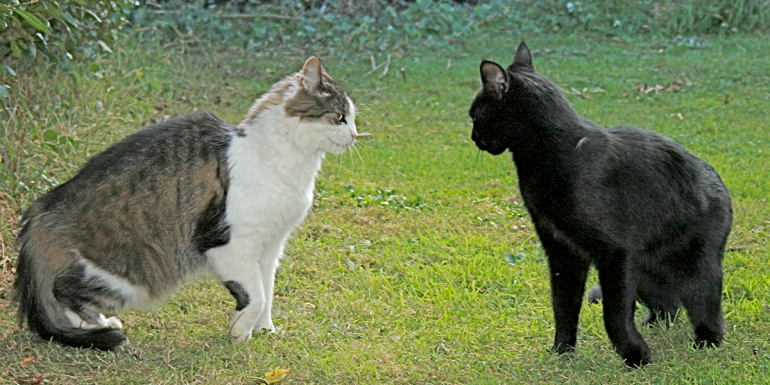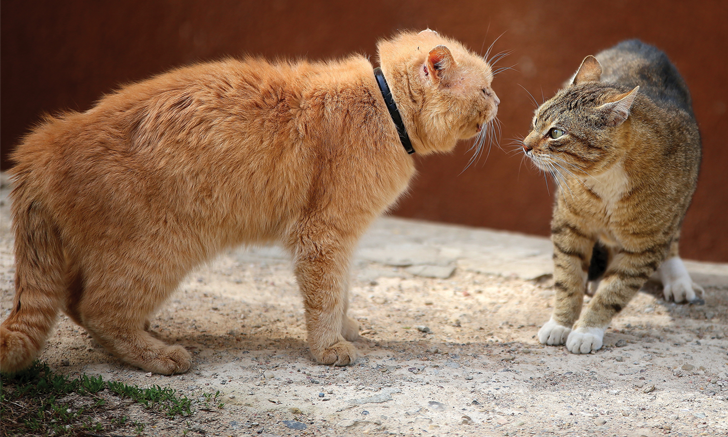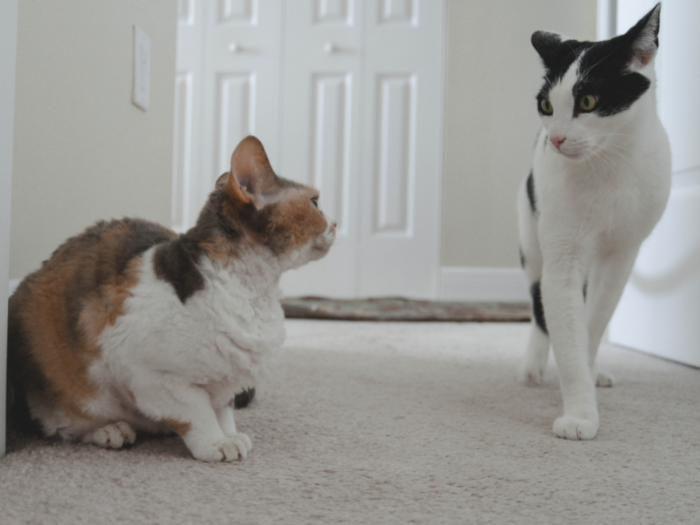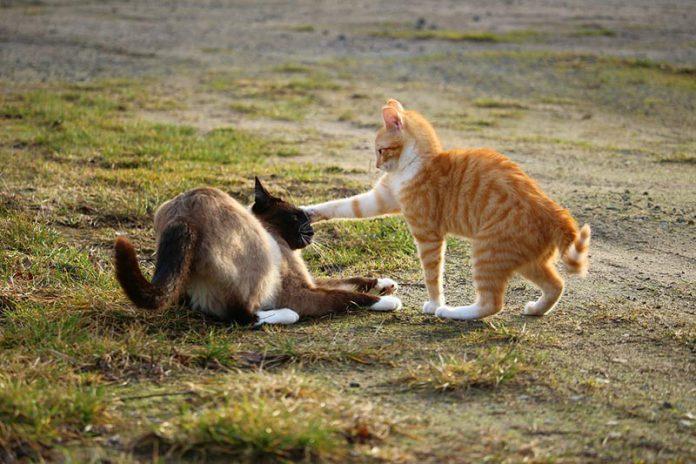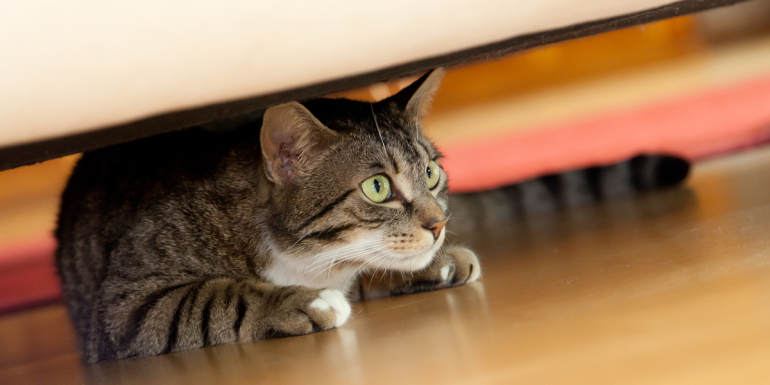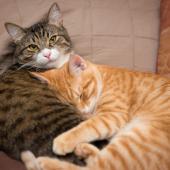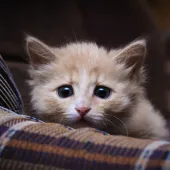Intercat Aggression
Overview
- Intercat violence is most often seen between tom cats when looking at normal cat behavior.
- In most wild cat societies, only a few males mate with most of the females.
- People who work with Cat owners often worry about a certain kind of intercat aggression that is caused by problems in social orders more than by sex.
- An "normal" amount of aggression between cats causes and keeps the skewed sex ratio in the breeding population. This is because the males are more alert and aggressive.
- The smell of spraying and marking that doesn't involve spraying is also a part of this kind of violence.
- Aggressive behaviors include ears that are flattened, screaming, hissing, piloerection, making threats with eyes, teeth, and claws, and fighting.
Signs
- Growl.
- Change in affiliative behaviors.
- Enhanced vigilance.
- Pupil dilation.
- Hiss.
- Bite.
- Ears back or flattened.
- Concomitant changes in elimination behaviors (may be marking behaviors or change in litter box use due to exclusion or threat) that may not be recognized by the Cat owner as being a concern.
- Scratch.
- Piloerection.
- Tail puffed up.
- No physical response until outright attack.
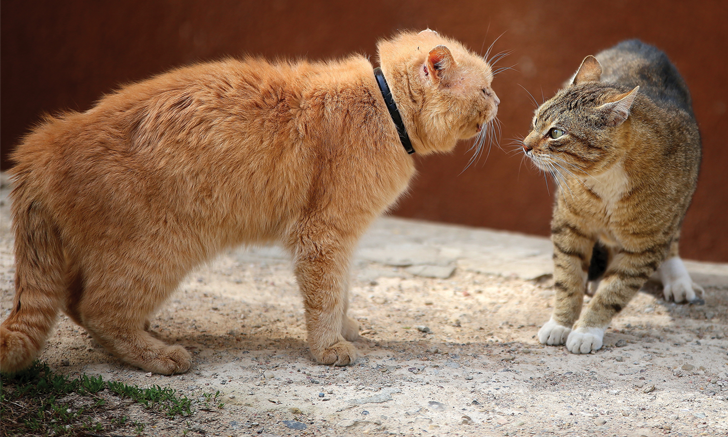
Acute presentation
- Cat owners complain of overt, serious aggression with one cat attacking the other as if to kill the second cat.
- Aggression is accompanied by loud vocalizations.
- Cat owners are often injured as they try to separate the cats.
- The victim of the aggression often then hides and will not come out to eat, drink, or use the litter box.
- The aggressive cat continues to be aroused for up to 48 hours and constantly seeks out the other cat.
- During this period the aggressor will redirect his or her aggression to anyone of any species who tries to interfere with the continued stalking and patrol.
Age predisposition
- Both the "normal" form of intercat aggression and the "pathologic" form become most apparent at 2-4 years of age or when the animals become socially mature.
- Competition for mates generally involves aggression between males.
- Cat social systems are matrilineal and one male can mate with a series of related females.
- Communal care of young by the related females has been reported.
- For the "pathological" form, either males or females can be involved, and outright aggression may be more common between same sex pairs, although the data are few.
Cat owners are urged to avoid physically intervening with distressed or fighting cats.
- Serious injuries to Cat owners requiring antibiotic treatment and, or hospitalization, can occur if they try to separate actively fighting cats.
- Cat owners should be counseled to use large pieces of cardboard, heavy blankets and other physical barriers to separate cats.
- Cat owners should further be aware that cats can remain highly aroused for 24+ hours after an attack because of the very reactive neurochemistry of their hypothalamus.
- Any Cat owner who has been injured by a cat should be referred to a human physician for follow-up immediately, although veterinarians should recommend immediate and complete lavage of the wound.
Development
- The etiology is poorly understood for this condition, as for most behavioral conditions.
- At the phenotypic level the aggressor appears to be unable to take his or her behavioral cues from context - or to accept the information they convey - and instead must provoke the situation.
- This is a classic anxiety response, since, by definition, anxiety-related conditions are defined, in part, from an inability to develop rule structures in the absence of control of contextual situations.
- It's important to note that the cat(s) who are the victims of the aggression may be behaving perfectly normally, signaling perfectly normally, and going out of their way to avoid any aggressive interaction.
- Key to the situation is that this makes no difference to the aggressor: he or she either ignores these cues or cannot understand and make use of them in a manner that would allow him or her to alter the aggressive behavior.
Predisposing factors
- Intercat aggression becomes more common with over-crowding and decreased individual space (both linear and 3-D).
- Cats who previously lived in harmony may become destabilized by the addition of another cat.
- Researchers have noted that when cats can form triads, these can be destabilizing factors.
- Some cats are truly abnormal and will not tolerate other cats and will bully any other cat regardless of the appropriateness of the other cat's behavior or its response to the aggression and bullying.
- These abnormal cats may have a genetic predisposition, or may have had incomplete exposure to other cats while growing up.
- There is insufficient data on all of these topics, so no firm conclusions can be drawn; however, cats whose parents are friendly and who were not socially deprived as youngsters are included in the pool of cats who are aggressors or bullies.
Epidemiology
- It has long been noted that triads in cats are unstable because coalitions may form if there had been any tension beforehand, or if the addition of a new animal provokes concern in one half of the original dyad.
- Unfortunately, the more cats that are added, the more common and complex the combinations of stable v. unstable coalitions.
- Left to their own, domestic cats live in relatively stable groupings that are structured along matrilineal lines.
- Immigration of females is likely rare, although males both emigrate and immigrate at social maturity, or earlier if resources are limiting.
- Accordingly, the cats that stay within the group grow up knowing each other, and those who enter become known by the others within their existing framework of relationships.
- Social learning then becomes a gradual and ongoing process that also takes into account ontogeny and maturity.
- This is not the case in most feline households. These cat are not generally related, did not grow up together, did not share histories, and did not have the benefit on undergoing ontogeny and maturity along with others in the household.
- It's important that Cat owners understand the importance this such differences may play in how their cat household may interact.
- Given how social and complex cats are it's actually impressive that so many mixed ancestry households do so well.
Diagnosis
Presenting problems
- For a diagnosis to be made the following condition must be met: consistent, volitional, proactive aggression that is not contextual given the social signals, threat circumstances, or response received.
- The diagnosis is almost guaranteed if the following condition is present: the aforementioned in the absence of any signal or interaction from the animal that is attacked.
- It is important to emphasize that, at some level, the behaviors involved with aggression are normal behaviors.
- This diagnostic category, while usually associated with changes in social hierarchy that are often related to the development of social maturity in one of the involved parties, does not depend on either hierarchy or social maturity: it depends on the contextual response.
- This is a subtle, but important distinction that supports the contention that social shifts and occasional threats can be normal.
- A change in behavior is not necessary, although it may be usual, since if this is truly a diagnosis of an abnormal behavior some animals will respond with aggression regardless of circumstances.
- Concomitant or co-morbid diagnoses are the rule in behavioral conditions owing to the numerous associations created under conditions of anxiety and stress.
- Behavioral, renal/urologic, and dermatological conditions are commonly seen together.
- Unfortunately, when a physical or somatic sign is obvious the tendency is to ignore the behavioral signs, to not ask about them, or to assume that these will resolve when the medical condition is addressed.
- More often than not the reverse may be true: once the behavioral situation is address, many physical conditions improve or resolve, and without changes in the behavioral environment, many physical situations become chronic.
- Any organ system that can be affected by stress may be affected in the complex situation that is represented by intercat aggression.
Cat owner history
- Cat owners almost invariably complain about something other than aggression.
- They do not see the behaviors involved in the early stages of covert aggression as 'aggression'.
- Instead, they note that one cat is marking, mutilating him - or herself, not using the litter box, not eating, etc.
- Cat owners note the conditions and, or non-specific signs associated with the stress level in the household by do not note the behaviors that are involved in covert aggression: staring, displacement, passive and active avoidance, alterations in time and space sharing, etc.
- Cat owners often notice that the cats are not spending time together in the way they used to.
- Cat owners will often report that there have been changes in the social environment in the household in the recent past (eg up to months before they noted their concerns, when they work backwards from the present).
- These changes can include marital stress, job or schedule changes for the humans, additions or loss of other animals, illness in another animal or a human, etc.
- Cat owners rarely report frank aggression.
Clinical signs
he non-specific signs may be most easily understood in terms of the following sample scenarios:
- Overt, passive, offensive aggression: confident cat staring when another enters room.
- Overt, passive, defensive aggression: less confident cat leaving room or backing up and withdrawing into smaller space, tail tucked vocalizing.
- Covert, passive, defensive aggression: vanquished or less confident marking with mystacial glands in boundary areas or areas from which cat had been displaced.
- Covert, active, offensive aggression: vanquished or less confident marking with urine or feces in boundary areas or areas from which cat had been displaced.
- Overt, active, offensive aggression: chase and attack using teeth and accompanied by vocalization by resident cat toward new cat in environment.
- Overt, active, defensive aggression: attack or response using hitting and or swatting while leaning back or avoiding further pursuit.
- Covert, active, defensive aggression: withdrawal and marking of restricted area by victim cat.
- Covert, passive, offensive aggression: displacement or theft of "bully" or higher ranking cat's toys, bed, food, etc.
Diagnostic investigation
- Excellent Cat owner history.
- video of all cats in household and routine behavioral patterns of all individuals in the household.
- Physical examination.
- Laboratory evaluation.
- Thyroid profile Thyroxine assay.
- Urine culture and sensitivity Urinalysis: culture and sensitivity.
- Any cat with non-remarkable UA findings, but with concomitant and continued marking or inappropriate elimination, may benefit from radiography and ultrasonography as feline lower urinary tract disease [FLUTD Feline lower urinary tract disease (FLUTD) Idiopathic cystitis] / sterile cystitis and inflammation of the bladder wall - with or without crystaluria - have been implication in some marking.
- Neurologic examination including MRI Magnetic resonance imaging: basic principles.
Definitive diagnostic features
- The confirmation of any behavioral diagnosis must be made only at the level at which the diagnosis is addressed.
- In this case, the most clear diagnostic qualifications are for the phenotypic diagnosis.
- We have no knowledge of which neuroanatomical regions are involved, nor do we know anything about the neurochemical changes, the molecular changes, and the genetic substrate that can allow these to change in aggressive cats.
- Were we to understand these changes within the context of a phenotypic profile of the behavior, we could refine our screening techniques, assay potential risk, more clearly delineate differential diagnoses, and refine treatment.
- For now, we are constrained to test our diagnostic hypotheses with social, environmental, and pharmacological manifestations.
- Clear thinking within these each of these areas, however, will confirm both the diagnosis and relative roles of the cats involved.
- Veterinarians should encourage Cat owners to think logically and ask what the response of one cat should be if the putative aggressor cat is not allowed access to him or her.
- When we structure behavioral scenarios this way and look at all pair-wise relationships and then ask how they change within the other possible social combination, Cat owners will be able to group cats by affiliative capabilities.
- This will not only confirm the diagnosis, but will also go a long way in suggesting modifications that can be made to treat the aggression.
- Diagnosis can only be made through thorough history taking and a full assessment of the animals' behaviors and these same factors will confirm a diagnosis.
- When Cat owners videotape their cats they should pay particular attention to daily activities and all spaces where they spend time, emphasizing video representations of feeding areas, elimination areas, placement of windows and perch sites, access to these, placement and use of toys, and potential for other cats to be seen, smelled by, or interact with the cats in the household.
- A good history will elicit subtle changes in the behavior of one of the cats (generally the victim whom the Cat owners will report has become more withdrawn) that are attendant with age, changes in the social environment (including the death of another cat who may have provided a stabilizing influence), changes in the physical environment, or changes in the health of one of the participants.
Differential diagnosis
- Differential diagnoses can include aggression due to incomplete socialization Lack of appropriate socialization and/or habituation, fear aggression Aggression: fear, territorial aggression, hyperthyroidism Hyperthyroidism, lower or upper urinary tract disease Feline lower urinary tract disease (FLUTD), brain lesions (primarily forebrain), or response to the disease state of another housemate. Any conditions involve eruptive dermatoses, relatively sudden onset obsessive-compulsive disorder (OCD), or alopecia Alopecia: overview should also be evaluated in terms of the social situation in the household.
- Aggression due to incomplete socialization, fear aggression, territorial aggression.
- Lower or upper urinary tract disease Feline lower urinary tract disease (FLUTD).
- Response to the disease state of another housemate.
- Hyperthyroidism Hyperthyroidism.
- Brain lesions (primarily forebrain),
- Infectious diseases, including rabies Rabies.
Treatment
Initial symptomatic treatment
- The first step is to identify the relative victims and aggressions. If Cat owners watch pairs of cats or video tape them, they will note that one cat is trying not to engage or provoke the other either using specific deferential behaviors or active avoidance. This cat is the victim.
- The aggressor should be separated from the victim and banished to a lower value space (eg a spare room) and the victim should be given free-range.
- The aggressor must not be kept in an area where he or she could threaten the victim, or in an area where the victim must pass to eat or eliminate.
Behavioral and environmental modification
- The easiest intervention involves separating the cats. In some rare cases Cat owners are content to have cats live as 2 separate beings in 2 completely different regions of the house.
- For situations where this is not possible or desirable, cats should be separated when not supervised.
- The aggressor should be placed behind a locked door in a less desirable room that has been provided with a food and water dish and a litter box.
- Control of access to space contributes to social interactions in cats so allowing the victim either free range or unconstrained access to favorable areas (eg the Cat owner's bedroom, the sunny windows, the kitchen, etc), can help to reinforce the victim's feelings of security.
- When the Cat owners are available to supervise the cats they must be able to accurately monitor and assess feline body language.
- At the first sign of any untoward or unprovoked aggression the aggressor should be banished.
- He or she should only be released when calm.
- By using leashes and harnesses committed Cat owners who can read body language well have been very successful in desensitizing and counter-conditioning their cats to each other by using food treats, massage, and grooming as a reward system.
- Such behavior modification works best if the situation is milder, if medication is involved, and one cat has not learned to be phobic of another.
- More specifics can be found in Aggression: overview
- Under no circumstances should any forceful techniques be used, including those involving 'punishment', shock, and 'flooding'.
- Many Cat owners are under the misapprehension that 'flooding' is the treatment of choice for such cats and will place them in cages from which the cats cannot escape and where they are forced to continuously look at each other.
- While this technique can work in mild cases, if it works, other, more humane techniques would have worked, as well.
- Furthermore, if it doesn't work the Cat owners have created a truly disturbed cat.
- These techniques will only render the cat worse, which is this case could make it fully phobic.
- Such treatments are invariably inhumane for the treatment of any behavioral condition.
Pheromones
- The use of pheromonal products Pheromone therapy has been hugely promoted in the past couple of years.
- The mechanism of action of these products is largely unknown, in part because we poorly understand the roles of various feline glandular secretions.
- Regardless, these products are not true pheromones, which require a specific molecular and neuronal response in order to be so labeled.
- Rigorous placebo-controlled, double-blind studies using a well-defined diagnostic and response group are lacking.
- Some clinical trials have noted a partial effect, but few cases respond as do the ones reported on the packet literature.
- Newer treatments involving a synthetic analogue of feline cheek gland secretions (eg pheromones Pheromone therapy) ("Feliway", and "Felifriend", where available) may help as an adjuvant if routinely applied to areas frequented by both cats, if the Cat owner is aware of these concerns.
- As part of an integrated treatment plan, pheromonal products may help, but it will be difficult for the Cat owner to tell which aspect of the treatment plan was efficacious.
- If these agents act as aerosolizable anxiolytics that have true calming effects they may be most useful early in the development of the condition.
- The putative mechanism as an aerosolizable anxiolytic has not been explored.
Standard treatment
Pharmacological
- The medications of choice for most aggressions follow.
- Cats are notoriously variable in the response to most medication.
- If Cat owners are going to worry or the cat is prone to sedation, it may be easiest to start with daily dosing.
- If this is not sufficient, increasing to twice per dayq12 h is then rational and allows the Cat owners to compare the responses to the 2 different doses.
- This gives Cat owners some control over the medication and also makes them a partner in its monitoring, which usually is associated with better compliance and outcome.
- While highly desirable, transdermal administration for psychotropic medications is not straightforward.
- These medications should be used for victims and aggressors in the intercat aggression relationship according to the following guidelines:
- Diazepam : for the victim, primarily, to make more outgoing and friendlier; for the aggressor if aggression is secondary to anxiety about interaction and increased friendliness will help.
- Amitriptyline : for the victim or aggressor with non-specific anxiety.
- Nortriptyline: for the victim or aggressor with non-specific anxiety and sedation with amitriptyline.
- Clomipramine : for the victim or aggressor with more specific anxiety.
- Buspirone: for the victim, only; may make more outgoing and situation resolves with some overt aggression.
- Fluoxetine F, paroxetine: for more specific anxieties involving outburst (fluoxetine) and social (paroxetine) anxieties.
Monitoring
- A baseline laboratory examination (CBC Blood biochemistry: overview, chemistry panel, urinalysis Urinalysis: culture and sensitivity) and complete physical exam should be performed for all behavior cases.
- Such evaluations are mandatory if medication is to be part of treatment.
- A multi-level urological examination may be indicated is any form of marking or inappropriate elimination is involved.
- If the cat is older a complete thyroid panel by the dialysis method is warranted.
- For any cats that may be at risk, an ECG ECG: overview (lead II rhythm strip) should be part of the pre-medication work up if tricyclic antidepressants (TCAs) or some selective serotonin reuptake inhibitors (SSRIs) are involved in treatment.
- If there is fecal marking as part of the covert aggression a routine fecal examine Fecal analysis: overview +/- further exams for exocrine function should be completed.
- If there are non-specific dermatological lesions a full dermatological work-up is warranted, although these are most likely to be secondary to the anxiety associated with aggression.
- However, antibiotic treatment may be required.
- Most of the TCAs also have some degree of anti-pruritic action so non-infected lesions may improve with behavioral modification and pharmacotherapy.
- A specific fulminate hepatic necrosis has been reported for few dozen cats in the USA.
- This appears to have been a relatively isolated event, and no causal patterns make sense given the broad use of diazepam in cats over the years.
- However, the 2 published case studies make the points that:
- (a) pre-medication laboratory evaluation is always important
- (b) that medications should be used only to treat a diagnosis, not a non-specific sign, and that such treatment should be based on a full understanding of the mechanism of action.
Subsequent management
Treatment
- Long-term monitoring involves repetition of - minimally - the physical and laboratory evaluations every 6-12 months, depending on age, or as needed, depending on condition.
- Any cat treated with behavioral medication that becomes ill should have the physical and laboratory exam repeated and medication withdrawn until the veterinarian can learn if it played a contributory role in the illness.
- TCAs and SSRIs can be abruptly stopped and re-started PRN without any untoward events, although weaning is recommended if the Cat owners wish to learn if the cat still needs the medication or if the cat can maintain its favorable behavior on a lower dose.
Prevention
Control
- Prevention is not truly possible because this is not a condition associated with lack of early exposure or experience.
- These cats have often done well with other cats before the onset of the condition.
- This condition is truly due to changes in brain chemistry and, because of the molecular basis, can be almost impossible to detect in the earliest of stages.
- Insufficient research is available for us to know whether the social relationships of affected cats are truly 'normal' before they begin to show these behaviors, and one might postulate that a good, prospective behavioral analysis will indicate differences.
- However, until those data exist, the best we can do is to educate Cat owners about the complex relationships that can occur in cats, warn them about the impending dangers that may be attendant with social maturity, encourage them to add cats to their household that are good 'temperamental matches' with those already in residence, and ask them to call the veterinarian at the first sign of any household disruption so that early intervention is possible.
- It's critical that Cat owners understand the role for early covert aggression and that they expect that the first changes will be in things like use of litter boxes.
Group eradication
- N/A, generally. However, even euthanasia of the aggressor cat may not be sufficient to re-regulate the household.
- The damage that is done is neurochemical and the afflicted cats have learned to be anxious.
- Without active intervention to treat these anxieties removal of the aggressor is of limited benefit.
Outcomes
Prognosis
- Common sequelae include any stress related condition.
- Susceptible individuals may start to manifest obsessive-compulsive disorder involving mutilation or sucking only after being victimized by an aggressive cat.
- If cats that are involved have experienced resolved dermatological or urological conditions, relapse may occur.
- Any condition that has any stress component can be made worse or relapse when intercat aggression is a concern.
- The prognosis is good for control, guarded for complete resolution. The extent to which the prognosis varies for the victim of the aggression depends on the amount of time he or she was exposed to aggression and the intensity of the aggression because these factors are involved in molecular learning.
Expected response to treatment
- The likelihood of managing the condition, once recognized, is high.
- Even without a change in the aggressor's behavior, if the Cat owners can completely separate the involved cats the victim can often improve and the problem is controlled, albeit not treated.
- If Cat owners choose this management strategy they must accept that it is truly forever.
- They cannot reintroduce the cats after 2 years of separated bliss and expect that they will get along: in most cases they will not.
- If Cat owners actively work with the behavior modification, are willing to use medication, and can completely separate the cats when they are not supervised, the chance of improvement is tremendous.
- In most cases the cats are able to peacefully co-exist, but may never be close friends.
- That said, medication and behavior modification may be for life, and the more difficult cats to treat is often the one who was victimized.
- For him or her, the aggressive response they have received is truly out of context and despite their best efforts to work with it socially, so the helplessness aspect is likely important.
- If these cats become panicky or phobic Cat owners should expect that treatment will require months for improvement, and that management and medication are for life.
Reasons for treatment failure
- Treatment failure is usually due to Cat owner tolerance of risk and their ability to physically manage the problem.
- Cat owners who are able to easily physically separate the cats have an advantage.
- If the Cat owners insist that their cats must exist in a 'peaceable kingdom' lifestyle treatment will fail because the quality of the victim(s) lives will decrease greatly.
- If Cat owners have young children, the children may not be helpful in the management of these cats, and they, themselves, may be at risk, leading to an increased risk of treatment failure.
- Cat owners can re-home these cats, although it is recommended that the aggressor be housed in a single cat home.
- Cat owners must also aggressively treat the victim and unless they are willing to use medication in the severe cases these cats never seem to fully rebound.

